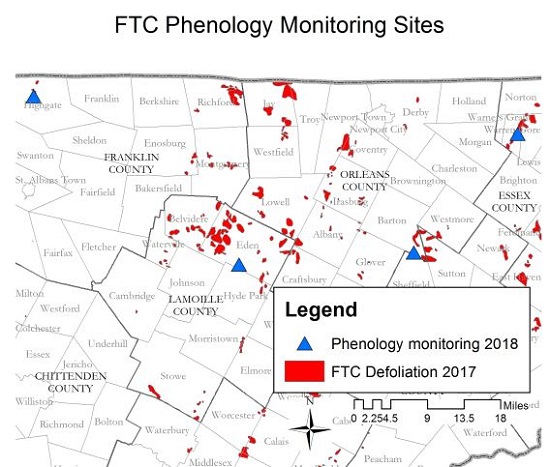This forest tent caterpillar phenology monitoring webpage will provide information about insect and maple leaf development to assist in predicting the timing of aerial spray application for sugarmakers.
Background: Forest tent caterpillars hatch in early spring and their development is closely tied to host plants, especially sugar maples. The caterpillars typically hatch just as the new leaves begin to grow and in some years, hatch before the buds of host trees have opened. They are exposed to changing weather and in some years late-season frosts destroy their food supply. The young caterpillars are adapted to feed within a narrow window, before chemical and physical changes make the foliage less palatable.
Spray Timing: Bt is not a contact insecticide; caterpillars must eat sprayed leaves, after which they will stop feeding and die. Ideal spray timing is after all eggs have hatched and started to feed, and when the leaves are fully expanded and large enough to catch spray droplets (at least 20% of full size). Click here for more information about Bt.
Phenology Monitoring in 2018: The Vermont Department of Forests, Parks and Recreation and cooperators are monitoring four locations in northern Vermont as sugar maple leaves emerge, and will continue through leaf-out. Sites will be visited weekly and this website will be updated accordingly with current information. See the map for monitoring point locations (blue triangles) and information below for our most recent observations of insect and leaf development at the four locations.
FTC Phenology Monitoring Locations
Barton, Vermont – 5/24/18 – Full leaves present, caterpillars present, defoliation starting
Eden, Vermont – 5/22/18 – Full leaves present, caterpillars present, no defoliation
Highgate, Vermont – 5/22/18 – Full leaves present, caterpillars present, defoliation beginning
Warren’s Gore, Vermont – 5/22/18 - Full leaves present, caterpillars present, no defoliation
Landowners are encouraged to monitor phenology on their own property to more precisely time Bt application. We have developed a Forest Tent Caterpillar Phenology Monitoring Protocol - 2018 to help you monitor your local conditions.
Current Growing Degree Days
Growing degree days (GDD) are another tool that may be useful. The Regional Growing Degree Day map shows the number of days above 50 degrees, as calculated from local weather stations. This may help interpret how the phenology observations at one site may compare to another location.

